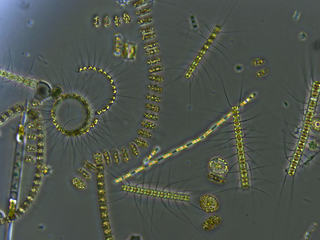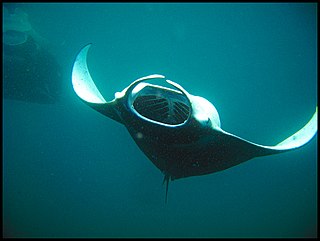Related Research Articles

The Antarctic Circumpolar Current (ACC) is an ocean current that flows clockwise from west to east around Antarctica. An alternative name for the ACC is the West Wind Drift. The ACC is the dominant circulation feature of the Southern Ocean and has a mean transport estimated at 100–150 Sverdrups, or possibly even higher, making it the largest ocean current. The current is circumpolar due to the lack of any landmass connecting with Antarctica and this keeps warm ocean waters away from Antarctica, enabling that continent to maintain its huge ice sheet.

Marine biology is the scientific study of the biology of marine life, organisms in the sea. Given that in biology many phyla, families and genera have some species that live in the sea and others that live on land, marine biology classifies species based on the environment rather than on taxonomy.

Plankton are the diverse collection of organisms found in water that are unable to propel themselves against a current. The individual organisms constituting plankton are called plankters. In the ocean, they provide a crucial source of food to many small and large aquatic organisms, such as bivalves, fish and whales.

An algal bloom or algae bloom is a rapid increase or accumulation in the population of algae in freshwater or marine water systems. It is often recognized by the discoloration in the water from the algae's pigments. The term algae encompasses many types of aquatic photosynthetic organisms, both macroscopic multicellular organisms like seaweed and microscopic unicellular organisms like cyanobacteria. Algal bloom commonly refers to the rapid growth of microscopic unicellular algae, not macroscopic algae. An example of a macroscopic algal bloom is a kelp forest.

Phytoplankton are the autotrophic (self-feeding) components of the plankton community and a key part of ocean and freshwater ecosystems. The name comes from the Greek words φυτόν, meaning 'plant', and πλαγκτός, meaning 'wanderer' or 'drifter'.

Zooplankton are the animal component of the planktonic community. Plankton are aquatic organisms that are unable to swim effectively against currents. Consequently, they drift or are carried along by currents in the ocean, or by currents in seas, lakes or rivers.

Chukchi Sea, sometimes referred to as the Chuuk Sea, Chukotsk Sea or the Sea of Chukotsk, is a marginal sea of the Arctic Ocean. It is bounded on the west by the Long Strait, off Wrangel Island, and in the east by Point Barrow, Alaska, beyond which lies the Beaufort Sea. The Bering Strait forms its southernmost limit and connects it to the Bering Sea and the Pacific Ocean. The principal port on the Chukchi Sea is Uelen in Russia. The International Date Line crosses the Chukchi Sea from northwest to southeast. It is displaced eastwards to avoid Wrangel Island as well as the Chukotka Autonomous Okrug on the Russian mainland.
Ice algae are any of the various types of algal communities found in annual and multi-year sea or terrestrial ice. On sea ice in the polar oceans, ice algae communities play an important role in primary production. The timing of blooms of the algae is especially important for supporting higher trophic levels at times of the year when light is low and ice cover still exists. Sea ice algal communities are mostly concentrated in the bottom layer of the ice, but can also occur in brine channels within the ice, in melt ponds, and on the surface.

Thin layers are concentrated aggregations of phytoplankton and zooplankton in coastal and offshore waters that are vertically compressed to thicknesses ranging from several centimeters up to a few meters and are horizontally extensive, sometimes for kilometers. Generally, thin layers have three basic criteria: 1) they must be horizontally and temporally persistent; 2) they must not exceed a critical threshold of vertical thickness; and 3) they must exceed a critical threshold of maximum concentration. The precise values for critical thresholds of thin layers has been debated for a long time due to the vast diversity of plankton, instrumentation, and environmental conditions. Thin layers have distinct biological, chemical, optical, and acoustical signatures which are difficult to measure with traditional sampling techniques such as nets and bottles. However, there has been a surge in studies of thin layers within the past two decades due to major advances in technology and instrumentation. Phytoplankton are often measured by optical instruments that can detect fluorescence such as LIDAR, and zooplankton are often measured by acoustic instruments that can detect acoustic backscattering such as ABS. These extraordinary concentrations of plankton have important implications for many aspects of marine ecology, as well as for ocean optics and acoustics. Zooplankton thin layers are often found slightly under phytoplankton layers because many feed on them. Thin layers occur in a wide variety of ocean environments, including estuaries, coastal shelves, fjords, bays, and the open ocean, and they are often associated with some form of vertical structure in the water column, such as pycnoclines, and in zones of reduced flow.
Alexandrium fundyense is a species of dinoflagellates. It produces toxins that induce paralytic shellfish poisoning (PSP), and is a common cause of red tide. A. fundyense regularly forms massive blooms along the northeastern coasts of the United States and Canada, resulting in enormous economic losses and public health concerns.

A harmful algal bloom (HAB) is an algal bloom that causes negative impacts to other organisms by production of natural algae-produced toxins, mechanical damage to other organisms, or by other means. HABs are sometimes defined as only those algal blooms that produce toxins, and sometimes as any algal bloom that can result in severely lower oxygen levels in natural waters, killing organisms in marine or fresh waters. Blooms can last from a few days to many months. After the bloom dies, the microbes that decompose the dead algae use up more of the oxygen, generating a "dead zone" which can cause fish die-offs. When these zones cover a large area for an extended period of time, neither fish nor plants are able to survive. Harmful algal blooms in marine environments are often called "red tides".

Akashiwo sanguinea is a species of marine dinoflagellates well known for forming blooms that result in red tides. The organism is unarmored (naked). Therefore, it lacks a thick cellulose wall, the theca, common in other genera of dinoflagellates. Reproduction of the phytoplankton species is primarily asexual.

A planktivore is an aquatic organism that feeds on planktonic food, including zooplankton and phytoplankton. Planktivorous organisms encompass a range of some of the planet's smallest to largest multicellular animals in both the present day and in the past billion years; basking sharks and copepods are just two examples of giant and microscopic organisms that feed upon plankton. Planktivory can be an important mechanism of top-down control that contributes to trophic cascades in aquatic and marine systems. There is a tremendous diversity of feeding strategies and behaviors that planktivores utilize to capture prey. Some planktivores utilize tides and currents to migrate between estuaries and coastal waters; other aquatic planktivores reside in lakes or reservoirs where diverse assemblages of plankton are present, or migrate vertically in the water column searching for prey. Planktivore populations can impact the abundance and community composition of planktonic species through their predation pressure, and planktivore migrations facilitate nutrient transport between benthic and pelagic habitats.

Cochlodinium polykrikoides is a species of red tide producing marine dinoflagellates known for causing fish kills around the world, and well known for fish kills in marine waters of Southeast Asia. C. polykrikoides has a wide geographic range, including North America, Central America, Western India, Southwestern Europe and Eastern Asia. Single cells of this species are ovoidal in shape, 30-50μm in length and 25-30μm in width.

Dinoflagellates are eukaryotic plankton, existing in marine and freshwater environments. Previously, dinoflagellates had been grouped into two categories, phagotrophs and phototrophs. Mixotrophs, however include a combination of phagotrophy and phototrophy. Mixotrophic dinoflagellates are a sub-type of planktonic dinoflagellates and are part of the phylum Dinoflagellata. They are flagellated eukaryotes that combine photoautotrophy when light is available, and heterotrophy via phagocytosis. Dinoflagellates are one of the most diverse and numerous species of phytoplankton, second to diatoms.

Marine protists are defined by their habitat as protists that live in marine environments, that is, in the saltwater of seas or oceans or the brackish water of coastal estuaries. Life originated as marine single-celled prokaryotes and later evolved into more complex eukaryotes. Eukaryotes are the more developed life forms known as plants, animals, fungi and protists. Protists are the eukaryotes that cannot be classified as plants, fungi or animals. They are mostly single-celled and microscopic. The term protist came into use historically as a term of convenience for eukaryotes that cannot be strictly classified as plants, animals or fungi. They are not a part of modern cladistics because they are paraphyletic.

Marta Estrada Miyares is a Catalan researcher, with a career in oceanography and marine biology. Her most prominent studies are based on the physiological characterization and ecological impact of algae and phytoplankton.
Ana María Gayoso was an Argentine marine biologist, a specialist in study of marine phytoplankton, best known for being the first scientist to describe phytoplankton in the Bahía Blanca Estuary, and to initiate the sustained long-term oceanographic dataset in this ecosystem. She made significant contributions to the understanding of harmful algal blooms caused by toxic dinoflagellate species in the Patagonian gulfs, and was the first scientist to describe high abundances of the coccolithophore Emiliania huxleyi in the Argentine Sea, a key component in the primary productivity along the Patagonian Shelf Break front in the SW South Atlantic. She started the most extensive (1978-present) long-term database of phytoplankton and physico-chemical variables in South America, in a fixed monitoring site in the Bahía Blanca Estuary. She died on 28 December 2004 in Puerto Madryn.
Susanne Menden-Deuer is an oceanographer and marine scientist known for her work on marine food webs, including their structure and function. As of 2022 she is president-elect of the Association for the Sciences of Limnology and Oceanography.
References
- 1 2 "Polar Discovery : Expedition 5 :: Meet the Krill Teams". polardiscovery.whoi.edu. Retrieved 2022-02-03.
- ↑ "Polar Discovery : Expedition 5 to the Bering Sea". polardiscovery.whoi.edu. Retrieved 2022-02-03.
- ↑ "Evelyn Lessard" . Retrieved 2022-02-03.
- 1 2 "Evelyn Lessard". College of Environment, University of Washington.
- ↑ Richtel, Matt (2016-07-18). "A Dreaded Forecast for Our Times: Algae, and Lots of It". The New York Times. ISSN 0362-4331 . Retrieved 2022-02-03.
- ↑ US Department of Commerce, National Oceanic and Atmospheric Administration. "Gulf of Mexico: Harmful Algal Blooms". oceanservice.noaa.gov. Retrieved 2022-02-03.
- ↑ Ph.D, Evelyn LessardUniversity of Washington Seattle | UW · School of Oceanography. "Evelyn LESSARD | Professor (Full) | Ph.D. | University of Washington Seattle, Seattle | UW | School of Oceanography". ResearchGate. Retrieved 2022-02-03.
- ↑ Lessard, Evelyn; Swift, E. (1985-07-01). "Species-specific grazing rates of heterotrophic dinoflagellates in oceanic waters, measured with a dual-label radioisotope technique". Marine Biology. 87 (3): 289–296. doi:10.1007/BF00397808. S2CID 83865201.
- ↑ "Tracing the source and fate of biopolymers in seawater: application of an immunological technique". www.academia.edu. Retrieved 2022-02-03.
- ↑ Lessard, Evelyn J. (1993), "Culturing Free-Living Marine Phagotrophic Dinoflagellates", Handbook of Methods in Aquatic Microbial Ecology, CRC Press, pp. 67–75, doi:10.1201/9780203752746-9, ISBN 978-0-203-75274-6 , retrieved 2022-02-03